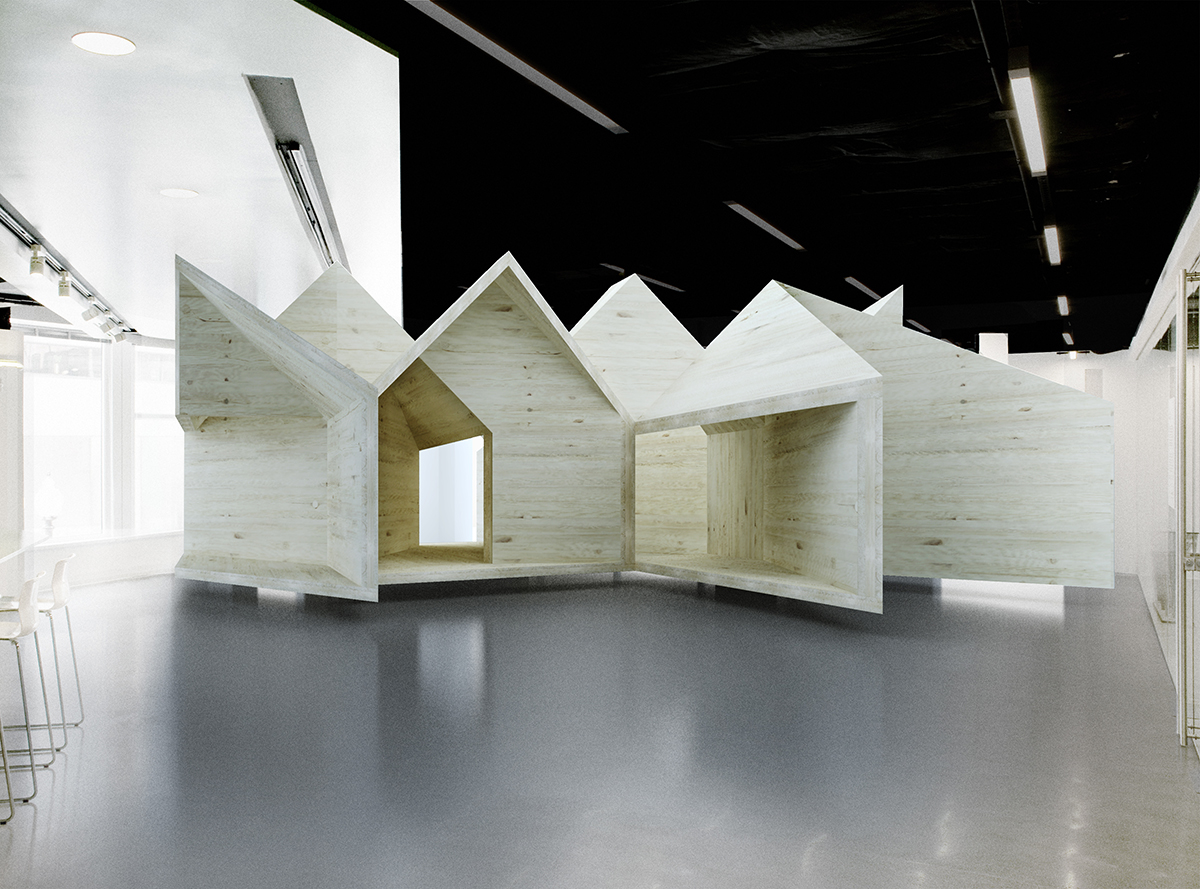BSA Space’s ‘Urban Timber’ Aims to Improve Wood’s Reputation

Finalists Yasmin Vobis and Aaron Forrest worked with a mentor architect, mentor engineer, and material supplier to create the “Four Corners” installation for the “Urban Timber” exhibit at BSA Space, one of the four winning projects selected from an open competition. (Photo courtesy of BSA Space)
Wood burns. When placed against steel or concrete, it tends to be thought of as an inferior material due to its combustibility, especially when applied to construction in urban environments. But the new exhibit “Urban Timber: From Seed to City” opening Thursday night at BSA Space aims to improve wood’s reputation, celebrating its sustainability and versatility.
“I’ve always had a great appreciation for wood as a material. It should be considered either as a substitute for or alongside steel and concrete in urban environments,” says co-curator Yugon Kim, who has a background as an architect and sculptor, in a phone interview earlier this week. Kim curated and designed the exhibit with Tomomi Itakura, his former classmate at Harvard Graduate School of Design and current partner at the design firm IKD.
Kim and Itakura sought to debunk myths associated with timber construction ingrained in society centuries ago by events like the Great Fire of Boston in 1872 and the building codes that followed, which restricted sizes and heights of timber buildings.
To help dispel misconceptions, “Urban Timber” presents recent innovations in wood technology, such as CLT—cross-laminated timber, a high-strength material that’s gained popularity in Europe throughout the past 20 years and has recently become available in North America. It has a higher resistance to fire because of its thickness, since the outer layers, when charred, protect the inner layers.
“The best way to describe it is if you look at a forest fire, all the small trees burn because their diameters are quite small, but all the big trees remain because of their mass and diameter,” Kim says. “If timber is sized appropriately, it is actually safer and more predictable than steel because steel actually fails in intense heat, but timber in that same heat will still maintain its structure.”
The exhibition also highlights sustainability as a benefit of timber construction—combating climate change by using wood to reduce carbon emissions and fossil fuel consumption.
“If we are to increase timber production, we should also increase sustainable forest practices,” Kim says. “We go through a number of reasons as to why sustainable forest practices are sustainable not only for timber production, but also help to minimize forest fires and increase the ability of trees to remove carbon from the atmosphere.”
The exhibit walks through every stage of a tree’s life cycle, following its growth, manufacturing, and even discussing the benefits of dismantling rather than demolishing wood buildings. It presents case studies of successful implementation of timber construction in taller buildings, as well as installations by four architecture teams chosen for their innovative approaches to uses of the material. After being selected, the teams spent a year developing their projects with mentor architects, engineers, and material fabricators.
“What was really important to me was the ability for them to learn through making. They refined their design, worked with experts to help them learn about the material. It was interesting to see how their design evolved,” Kim says. “They gained some additional knowledge, and hopefully under the influence of this experience, in the future they now will also build with timber.”
But Kim also hopes that the exhibit’s reach will extend beyond aspiring and practicing architects.
“[BSA Space] is right across from the Children’s Museum, and the installations are quite fun, so we’re hoping that children will come in and see them and the parents will come look at the information, and it’ll start some conversation,” he says. “We’re always so hard-wired to think of steel and concrete when we think of our cities. This exhibit is not only for practitioners, but more so for the common viewer to just imagine what a timber city might be like.”

The “Four Corners” installation turns the traditional timber-framed New England barn inside out using cross-laminated timber. (Photo courtesy of BSA Space)
The opening reception for “Urban Timber: From Seed to City” takes place Thursday, June 26, from 6 to 8 p.m. at BSA Space, 290 Congress St., Boston. Admission is free, and the exhibit will run until September 30. For more information, visit architects.org.


